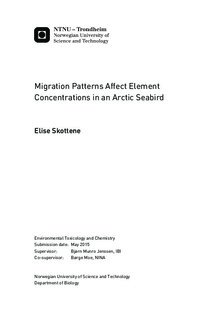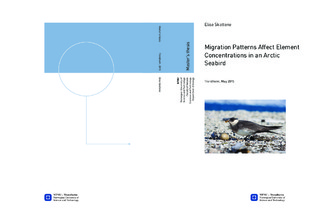| dc.description.abstract | Arctic seabirds have often been used to assess metal levels in remote regions. Most Arctic-breeding seabirds are migratory, and differences in wintering locations and migration patterns have been suggested to affect their element concentrations. In a separate part of this project, the migration patterns and wintering areas in a Svalbard-breeding population of Arctic skuas (Stercorarius parasiticus) were determined (America, West Africa, the Gulf of Guinea and the Mediterranean). In the present study, the effects of winter areas on feather and blood concentrations of mercury (Hg), selenium (Se), cadmium (Cd), lead (Pb) and zinc (Zn) were investigated in this population of Arctic skuas. Relationships between feather and blood concentrations were examined, and the temporal consistency of each element in the Arctic skuas was quantified by calculating their repeatabilities (REPs). Blood samples (collected during the breeding seasons from 2009-2013) and feather samples (from 2010 to 2013) from 23 breeding adult Arctic skuas were analysed for elements. There were significant differences in feather concentrations of all the elements among Arctic skuas migrating to the different wintering areas. Feather concentrations of Hg, Se and Cd had high REPs, which implies similar individual dietary exposure to these elements within wintering areas among years. Blood concentrations of Hg and Se differed significantly among the wintering Arctic skuas, and the individual levels of these elements remained consistent between the years. There were significant relationships between feather and blood concentrations of Hg, Se, Cd and Zn. These relationships suggest that concentrations of these elements obtained during the winter affected circulating blood levels during the breeding season. Hg and Se seemed to be released from storage tissues into the bloodstream in concentrations reflecting winter levels, while Cd and Zn blood levels remained relatively similar among Arctic skuas with different migration strategies. Results concerning effects of migration on Pb blood concentrations were inconclusive because feather and blood concentrations did not correlate. High REP of Pb in blood indicates similar individual exposure to Pb in Kongsfjorden among years. Mean concentrations of Hg and Se were lower in blood of female Arctic skuas than in males, and the mean concentration of Hg was higher in blood of Arctic skuas breeding on islands of Kongsfjorden than in birds breeding on the tundra. Year was a significant predictor for Zn in feathers and blood. The results of this study emphasize the importance of considering migration patterns and wintering locations, in addition to factors such as sex, year and breeding location, when evaluating year-round and local exposure to potentially toxic elements. | |

